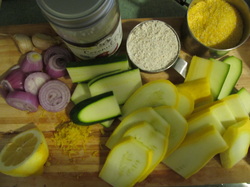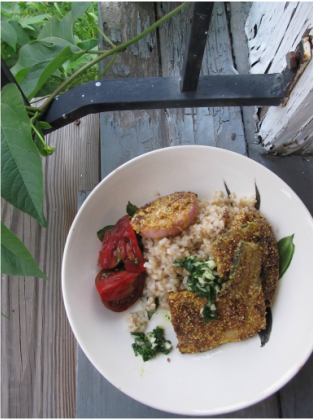 Finding Goodness in the Quotidian Part i. Cultivation On my “day job” farm, the production farm where I have been spending the vast majority of my waking hours this season, I have been playing the part of “cultivation manager,” a role I took on with much pride and glee, appreciating the responsibility and the opportunity. In non-farming terms, the Oxford English Dictionary defines cultivation as “the process of trying to acquire or develop a quality or skill;” the Merriam-Webster offers the definition of cultivate as “CULTURE: REFINEMENT.” Pertaining to soils and vegetable crops, cultivation refers to the mechanical (instead of chemical) means of controlling and eradicating weeds, aerating the soil to stimulate biological activity, and helping retail soil moisture by forming a layer of crumbly soil-mulch on the surface. Cultivation can be done by tractor, horse, hoe, or hand, usually working largest to smallest, or grossest to finest. Cultivation necessitates observation—careful, constant, attentive. Learning at what moisture level the soil is ready to be worked by tractors, humans, or horses—to be walked on or worked in by a few thousand pound wheels, thousand pound hooves, or light but still jarring blades of hoes and hand-tools. Learning when, how, and if to compromise soil integrity for weed management. Watching how tall the plants of summer squash can get before the belly-mounted implements on the tractor can no longer go over them without damaging leaves. Fingering samples of soil to see how many “white root” baby weed seeds have germinated, and therefore need to be tilled—exposed to air and wind and wither quickly in the sun. There have been moments this season, many of them, when I am riding on a small diesel tractor gliding over my 6th bed of leeks or head lettuce and think: Ah, this is it, this is the culmination of my farming career, these moments in the sun killing weeds by the thousand, working soil so as to lower the weed seed-bank, give room for the plants we want to eat to grow more fully. There have been moments, like driving over the 10th of 18 beds of sweet potatoes, before the thick branches have vined out too far in the rows, when the soil is dry but not dusty, and the clock is nearing seven so I am moving at a nice clip for the last eight beds of the day, and I think: this might be a little of what flying feels like, this generous and swift movement, this momentum across clean beds, my eyes focusing on the small blade of the sweep as it moves beside the bed, pushing away soil like an ongoing wave. In the middle of last week, cultivating fall brassicas late in the day, I looked up to notice a dozen blue and black white-breasted birds circling me and the tractor. At first I thought they were following to dine on the worms and bugs recently uncovered in the newly turned soil, but they never seemed to swoop down into the dirt, only moving ceaselessly around this machine and I. Watching them, I realized driving a tractor is nothing like flying. I can try and make it poetic or beautiful, and it may very well be poetic and beautiful to me, but it is not flying. It is nice, but it is not effortless movement through air catching horseflies for dinner with humble self-propelled ease. In theorizing about what he calls the Ordinary, author Thomas Dumm defines the ordinary as “the serendipitous repository of happiness” and it is this phrase which I recall in my moments of birds and tractors, this common experience of quotidian goodness we are so familiar with we sometimes forget it is present. These ordinary moments of work and leisure offer us authentic joy, moments in which we find great and acute interest in what immediately and daily surrounds us: the familiar, the everyday, the undisguised and easily dismissed moments which compose us. In quotidian goodness and the appreciation of the mundane, Your farmers, Lisa and Anton Part ii. Curcurbitacea
Polenta-Walnut Encrusted Summer Squash and Red Onion: Don't grow weary of summer squashes yet! Those tasty zucchinis still have a few weeks to go, and are versatile enough to be included in most culinary experiments, from curries to quiches to these tasty bites. Ingredients: 1 medium summer squash 1 medium zucchini 1 medium onion coconut oil for frying For the Crust: 1/2 C polenta or coarse corn meal 1/2 C walnuts, toasted in an oven or stove-top in a cast iron pan 1/3 C whole wheat flour fresh black pepper sea salt For the batter: zest of one lemon 1 large or 2 small eggs, beaten For the dressing: juice of one lemon, freshly squeezed a generous pour of high quality olive oil two cloves garlic, pressed and minced a handful of fresh parsley or basil leaves, minced fine a pinch of salt Cut Summer Squash and/or Zucchinis in half to form two shorter rounds. Slice each of the four quadrants length-wise into 1/4-inch "sheets" of squash. On the end pieces, cut off the skin to form a flat and absorbent surface. Slice the onion into 1/4-1/2 inch slices, careful to keep the layers in-tact. For the Walnuts: Toast whole or halved walnuts on a caste iron over medium heat (or in an oven), keeping a close watch and shaking the pan often. Let cool. Grind in a food processor or clean spice/ coffee grinder, or, bang with a wooden mallet in a well-sealed and sturdy plastic bag. Combine walnut-meal, polenta or coarsely-ground corn meal, wheat flour, salt, and pepper, and mix to incorporate. Zest one lemon (about 1 T) and add to scrambled egg. Heat 1+ tablespoons of coconut oil on cast-iron pan over medium heat. You can use another oil, but I wouldn't recommend it. The subtle flavor of coconut combined with lemon and squash is pretty lovely, and the coconut retains its clean flavor without burning at medium heat. Dip each vegetable slice into egg, getting each side wet, then toss into dry-mixture, coating each side fully. Cook in hot oil on medium heat until each side is crispy and browned, about 4-6 minutes per side. Adjust your heat to prevent from burning the squash. The onions need about double the time to cook thoroughly. Dress and Dine! To make the dressing: combine ingredients in a small bowl or jar and whisk with fork to combine. The flavor of garlic is strong; perhaps if you're making these for a first date you'd consider less garlic, or slightly cooking garlic in olive oil on low heat for a milder flavor. Serve and Eat warm, over rice and with a slice of tomato... or piping hot as a crispy appetizer with dressing to top. If you are feeling ambitious, these would be tasty with a dollop of home-made aioli. Have leftovers? The perfect addition to an open-faced sandwich. Reheat on the pan, add to a slice of toasted crusty whole-grain bread, top with thinly-sliced or grated parmesan, and a slice of tomato.
1 Comment
Leave a Reply. |
Archives
December 2019
FarmersAnton M. Shannon Categories
All
|


 RSS Feed
RSS Feed